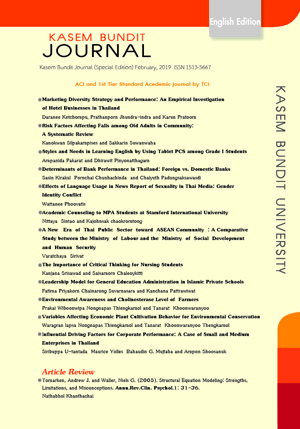Tomarken, Andrew J. and Waller, Niels G. (2005). Structural Equation Modeling: Strengths, Limitations, and Misconceptions. Annu. Rev. Clin. Psychol.1: 31-36.
Keywords:
Structural Equation Modeling, Strengths, Limitations, MisconceptionsAbstract
Structural Equation Modeling (SEM) is a second-generation multivariate statistical data analytic technique that is often used in current research in both natural and social sciences. This is mainly due to the believe that it can test theoretically supported linear and additive causal models. In the field of marketing, for example, with SEM marketers can virtually examine the relationships that exist among variables of interest in order to prioritize resources to better serve their customers. Additionally, the fact that unobservable, hard-to-measure latent variables can be used in SEM makes it ideal for tackling business research problems (Wong, 2013).
In principle, SEM involves observable or manifest variables or indicators and unobservable or latent variables, causal modeling, confirmatory factor analysis, multiple regression, and path analysis. SEM technique is used mainly to see if empirical data fit the proposed causal model by the examination of x2 and indexes of goodness of fit.
References
Devcik, Nebojsa S. (2014). The Use and Misuse of Structural Equation Modeling (SEM) in Management Research: A Review and Critique, Journal of Advance in Management Research, Vol. 11(1): 47-81.
Fox, John. (2006). Introduction to Structural Equation Modeling. Wu Wien: May/June.
Kerlinger, F.N. and Lee, Howard B. (2000). Foundations of Behavioral Research (4th edition). New York: Harcourt College publisher.
Wong, Ken Kwong-Kay. (2013). Partial Least Squares Structural Equation Modeling (PLS-SEM) Techniques using SmartPLS. Marketing Bulleting, 2013, 24, Technical Note 1. Available from : https:// marketing – bulletin massey ac.nz.
Downloads
Published
How to Cite
Issue
Section
License
ทัศนคติ ความคิดเห็นใด ๆ ที่ปรากฏในวารสารเกษมบัณฑิตฉบับนี้เป็นของผู้เขียน โดยเฉพาะ มหาวิทยาลัยเกษมบัณฑิตและบรรณาธิการ ไม่จำเป็นต้องมีความเห็นพ้องด้วย







